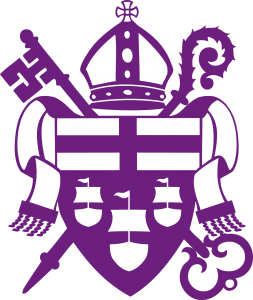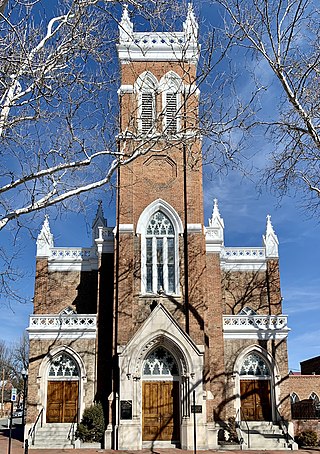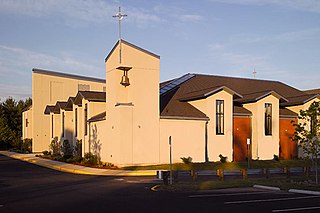
Truro Anglican Church is an Anglican church in Fairfax, Virginia, USA.

The Diocese of Virginia is the second largest diocese of the Episcopal Church in the United States of America, encompassing 38 counties in the northern and central parts of the state of Virginia. The diocese was organized in 1785 and is one of the Episcopal Church's nine original dioceses, with origins in colonial Virginia. As of 2018, the diocese has 16 regions with 68,902 members and 180 congregations.

Christ Church is an Episcopal church located at 118 North Washington Street, with an entrance at 141 North Columbus Street, in Alexandria, Virginia. Constructed as the main church in the Church of England's Fairfax Parish, the building was designed by Col. James Wren, a descendant of Sir Christopher Wren.
In the United States, the history of the Episcopal Church has its origins in the Church of England, a church which stresses its continuity with the ancient Western church and claims to maintain apostolic succession. Its close links to the Crown led to its reorganization on an independent basis in the 1780s. In the nineteenth and early twentieth centuries, it was characterized sociologically by a disproportionately large number of high status Americans as well as English immigrants; for example, more than a quarter of all presidents of the United States have been Episcopalians. Although it was not among the leading participants of the abolitionist movement in the early 19th century, by the early 20th century its social engagement had increased to the point that it was an important participant in the Social Gospel movement, though it never provided much support for the Prohibitionist movement. Like other mainline churches in the United States, its membership decreased from the 1960s. This was also a period in which the church took a more open attitude on the role of women and toward homosexuality, while engaging in liturgical revision parallel to that of the Roman Catholic Church in the post Vatican II era.

Pohick Church, previously known as Pohick Episcopal Church, is an Episcopal church in the community of Lorton in Fairfax County, Virginia, United States. Often called the "Mother Church of Northern Virginia," the church is notable for its association with important figures in early Virginian history such as George Washington and George Mason, both of whom served on its vestry.
The Anglican realignment is a movement among some Anglicans to align themselves under new or alternative oversight within or outside the Anglican Communion. This movement is primarily active in parts of the Episcopal Church in the United States and the Anglican Church of Canada. Two of the major events that contributed to the movement were the 2002 decision of the Diocese of New Westminster in Canada to authorise a rite of blessing for same-sex unions, and the nomination of two openly gay priests in 2003 to become bishops. Jeffrey John, an openly gay priest with a long-time partner, was appointed to be the next Bishop of Reading in the Church of England and the General Convention of the Episcopal Church ratified the election of Gene Robinson, an openly gay non-celibate man, as Bishop of New Hampshire. Jeffrey John ultimately declined the appointment due to pressure.

The Diocese of the Mid-Atlantic is an Anglican Church in North America diocese, encompassing Virginia, Maryland, Washington, D.C., and northeastern North Carolina, with 38 congregations, including several church plantings. The diocese was originally organized in 2006 as the Anglican District of Virginia when a group of Virginian congregations withdrew from the Episcopal Church. It achieved diocesan status on June 21, 2011.

The Falls Church is an historic Episcopal church, from which the city of Falls Church, Virginia, near Washington, D.C., takes its name. Established in 1732, the parish in 1769 built a brick church building that remains in use today.

The Episcopal Diocese of the Rio Grande is the Episcopal Church's diocese in New Mexico and southwest Texas, the portion of the state west of the Pecos River, including the counties of El Paso, Reeves, Culberson, Jeff Davis, Brewster, Presidio, Terrell, Hudspeth and Pecos. The total area of the diocese is 153,394 square miles (397,290 km2). According to the 2006 parochial report, there are 57 active congregations within the diocese. The see is based in Albuquerque, New Mexico and the diocesan cathedral is the Cathedral Church of St. John.

Martyn Minns is an English-born American bishop, serving in the Anglican Church of Nigeria. He was the founding missionary bishop of the Convocation of Anglicans in North America (CANA), under the patronage of the Anglican Church of Nigeria, until his retirement in January 2014. Prior to becoming a bishop, he served as rector of Truro Church in Fairfax, Virginia, in the United States.

St. Edmund's Anglican Church was a parish of the Convocation of Anglicans in North America in Elm Grove, Wisconsin.
Fairfax Parish was the ecclesiastical jurisdiction of the Anglican church in colonial Virginia with jurisdiction over part of Fairfax County with its central church located at The Falls Church. The parish was created in 1764 from Truro Parish.
Truro Parish was the ecclesiastical jurisdiction of the Anglican church in colonial Virginia with jurisdiction originally over all of Fairfax County. The parish had its central church at the Truro Church and the parish was named for the parish in Truro in Cornwall. The parish was created on November 1, 1732 from Hamilton Parish. It was divided twice: in 1748, Cameron Parish was formed and in 1764 Fairfax Parish was created. After 1765, Truro Parish covered southern Fairfax County until disestablishment ended the parish system by 1786.
Cameron Parish was the ecclesiastical jurisdiction of the Anglican church in colonial Virginia with jurisdiction over the western part of Fairfax County and, once it was created in 1757, over Loudoun County. The parish was named for the minor title of Thomas, Lord Fairfax, Baron of Cameron. The parish was created in 1748 from Truro Parish. It was divided in 1770 and Shelburne Parish was formed from the western half of Loudoun County. After 1770, Cameron Parish covered eastern Loudoun County until disestablishment ended the parish system by 1786.

The Church of the Epiphany is an Anglican church located in Chantilly, Virginia. It emphasizes "Encountering God through beautiful worship and believing prayer, building a multigenerational congregation that loves children and families and equipping every member to share the good news of Jesus Christ." Notable ministries and activities include a yearly free "Sports Camp" in Herndon for elementary-age students, bi-weekly worship and other ministry activities at the Arbor Terrace memory care home in Chantilly, and monthly donations of food that go home with students in need at Coates Elementary School in Herndon. Each year, Epiphany designates the congregation's Christmas Eve offering to a special project, alternating between supporting mission outside of the United States and meeting local needs in Fairfax County.

Christ Church, or Christ Episcopal Church, is an Anglican church in Winchester, Frederick County, Virginia. The church was founded in 1738, with its first vestry elected in 1742. It is the seat of Frederick Parish, Diocese of Virginia, which once covered half of the Shenandoah valley and western Virginia, including what became West Virginia. The current church building, the parish's third, was designed by Robert Mills - it was completed in 1828, and is the oldest church building continuously used for religious purposes in the county. It is a contributing building in the local Historic District which predates the National Register of Historic Places, and which has been expanded three times since 1980.

The Church of the Epiphany Episcopal is an Episcopal church within the Episcopal Diocese of Virginia in Oak Hill, Virginia, United States. The church was established in 1985 as a 'mission church' by members of Truro Episcopal Church and is listed in a book compiled in 1989 by Don Massey for the Episcopal Diocese of Virginia. The church is legally registered as Church of the Epiphany Episcopal while doing business as (DBA) Epiphany Episcopal Church, and is informally known as "The Church on the Corner."

Meade Memorial Episcopal Church is a predominantly Black Episcopal Church in Old Town Alexandria, Virginia. Founded in 1870, the church today is supported by a congregation that includes descendants of the original founders of this parish. Meade Memorial belongs to the Episcopal Diocese of Virginia, whose members continue to serve the community and the Episcopal Church by participating in regional and Diocesan activities.
James Wren was an American politician, judge, military officer, architect, and merchant. Historians regard Wren as one of colonial Virginia's only architects of record.

The Church of Our Saviour at Oatlands is a Reformed Episcopal parish located south of Leesburg, Virginia. Founded in 1871 as a parish of the Episcopal Diocese of Virginia, it met for most of its history in a historic church building on the grounds of the Oatlands plantation. The congregation elected to leave the Episcopal Church during the Anglican realignment and in 2016 relocated to a new building a mile north of the original historic church. It is noted for its use of the 1928 Book of Common Prayer.















